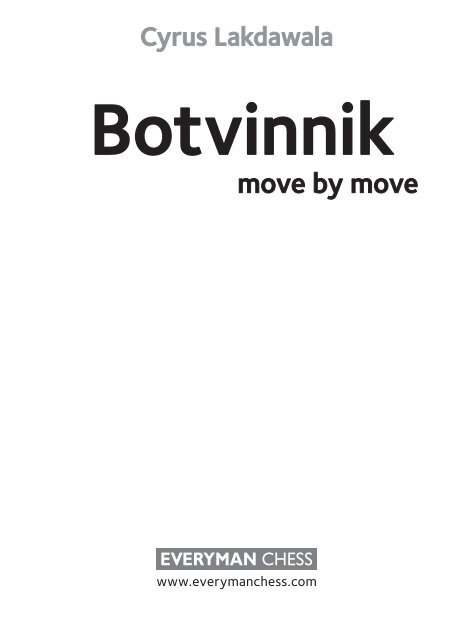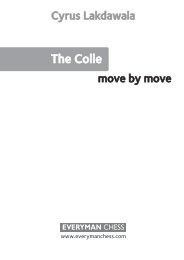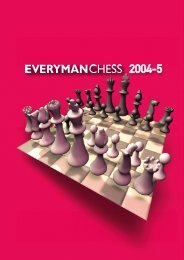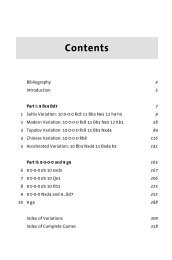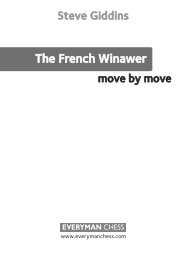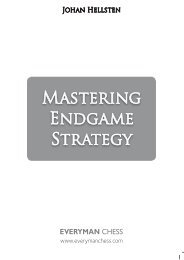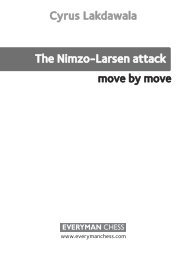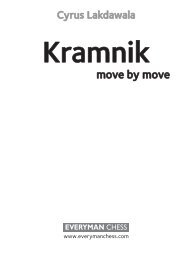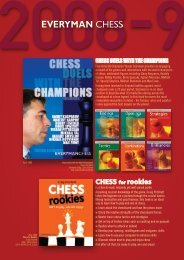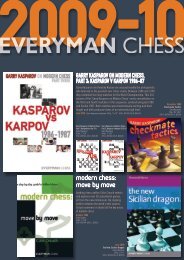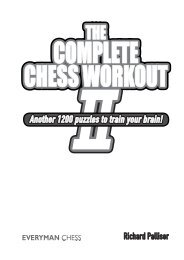Download sample pages. (pdf) - New In Chess
Download sample pages. (pdf) - New In Chess
Download sample pages. (pdf) - New In Chess
Create successful ePaper yourself
Turn your PDF publications into a flip-book with our unique Google optimized e-Paper software.
Cyrus LakdawalaBotvinnikmove by movewww.everymanchess.com
About the AuthorCyrus Lakdawala is an <strong>In</strong>ternational Master, a former National Open and American OpenChampion, and a six-time State Champion. He has been teaching chess for over 30 years,and coaches some of the top junior players in the US.Also by the Author:Play the London SystemA Ferocious Opening RepertoireThe Slav: Move by Move1...d6: Move by MoveThe Caro-Kann: Move by MoveThe Four Knights: Move by MoveCapablanca: Move by MoveThe Modern Defence: Move by MoveKramnik: Move by MoveThe Colle: Move by MoveThe Scandinavian: Move by Move
ContentsAbout the Author 3Bibliography 6<strong>In</strong>troduction 71 Botvinnik on the Attack 162 Botvinnik on Defence 893 Riding the Dynamic Element 1434 Botvinnik on Exploiting Imbalances 2075 Botvinnik on Accumulating Advantages 2566 Botvinnik on Endings 323<strong>In</strong>dex of Openings 397<strong>In</strong>dex of Opponents 398
<strong>In</strong>troduction“All told, there is not a single weakness in his armour.” – Reuben Fine.On August 17th 1911, in St Petersburg, a titan of the game entered the world. MikhailBotvinnik was born to a dentist mother, and a father who was a dental technician. Helearned chess at the unbelievably late age (for a world champion) of 12. It was love at firstsight. Botvinnik displayed staggering natural talent (although he claimed, rather outrageously,that he had little) and, through the help of his coach, Abram Model, won the 1931USSR Championship at age 20, the youngest to do so. <strong>In</strong> this period he casually annexed aPhD in Electrical Engineering as well. <strong>In</strong> fact he continued work as an engineer even asworld champion – unthinkable by today’s requirements to reach the most exalted level.Botvinnik claimed – a claim I don’t believe at all! – that his side job as engineer actuallyhelped him in his chess, since he was always hungry to play.By 1936 he was perhaps the strongest player in the world, demonstrated by his performanceat Nottingham, with an undefeated tie for first with Capablanca and ahead ofWorld Champion Alekhine. Due to the interruption of WWII, Botvinnik had to wait twelvelong years before he became the official sixth World Champion, after having won the great1948 World Championship tournament at The Hague/Moscow. He dominated the event,surging a full three (!) points ahead of his closest rival, Smyslov. There were whispers thatthe Communist Party authorities forced Botvinnik’s Soviet rivals to throw games, but thereis no proof of this. A similar charge was made later that Bronstein was forced to throw thenext to last game in his World Championship match versus Botvinnik, yet Bronstein’s widowvehemently denied the claim and said Botvinnik drew the match (and retained his title)fair and square.Max Euwe noted: “Most players feel uncomfortable in difficult positions, but Botvinnikseems to enjoy them!” The match format, Botvinnik’s forte, he considered the ultimate testof one’s character. Botvinnik held on to the title, which he subconsciously considered hisprivate property, for a full 15 years, with two intermissions – when Smyslov and Tal briefly“borrowed” his title. Botvinnik’s lengthy reign quite possibly surpassed Lasker’s, sinceLasker tended to dodge his great contenders, whereas Botvinnik faced all of them. Botvinnik,through dint of his superior preparation methods, decisively won both rematches.Smyslov he simply outprepped and outplayed strategically. But perhaps most impressivewas how he dodged Tal’s frantic attempts to complicate and forced his younger, less ex-7
Botvinnik: Move by Moveperienced (World Champion!) opponent into blocked positions and endings. Botvinnikquashed every attempt to confuse, and regained the title in convincing fashion, albeit bolsteredby Tal’s ill health.Botvinnik – along with Morphy, Capablanca, Fischer, Karpov (and Carlsen!?) – was thegreatest strategist of his day (or any day!). An argument can be made that Botvinnik wasthe single most important chess figure of the 20th century—yes, you heard me correctly.Perhaps even more so than Fischer. The reason: players such as Capablanca, Alekhine, Tal,Fischer, Karpov, Kasparov and Carlsen are merely isolated geniuses, all of whom producedbeautiful games, yet none revolutionized modern chess training into a formulation, aschool. Botvinnik, on the other hand, through his intensely rigorous pre-game preparationtechniques, was the father of the Soviet School of chess and, by proxy, the father of allmodern day professional preparation and coaching. Botvinnik’s secret (to Westerners)training techniques may be the main reason the Soviets took sole control over the worldchampionship title for the next quarter century, when only the anomaly of Bobby Fischerripped it from Soviet hands. The reason we all so frantically order and study the latestopening books is due to Botvinnik, who understood the deep importance of opening theoryand pre-game preparation.One senses from Botvinnik’s play, the residue of a rigorously efficient personality, utterlyincapable of tolerating failure in himself. And when he did fail (his losing matchesversus Smyslov and Tal) he returned to the rematches with demonic resurgence, upendingthe pretenders to what he considered his private kingdom: the title of World <strong>Chess</strong> Champion.He was a stern man, who, from my personal 1977 simul meeting with him as a teen,lacked affability. (He slammed and screwed in the pieces when he moved and glared atyour terrified, pimple-faced writer through those scary coke-bottle glasses of his, as a sternprincipal would to a difficult student.) Botvinnik, a lifelong, devout Communist Partymember, was a man his peers mostly disliked and distrusted, yet couldn’t help but respect.He was prone to make outrageous overstatements on perceived character flaws of his rivals,and yet, one senses, never bothered to ponder any particular defects in his own.Through chess, this incredibly confrontational personality discovered a novel method ofdiverting his monumental inner aggression into the harmless realm of the abstract.Botvinnik’s styleWith Botvinnik, there emerged a new style of play I call power chess—high end aggression,yet arising from strategic, not solely tactical bases. To my mind Vladimir Kramnik (Botvinnik’sstudent—yes, yes, I know: nobody equates Kramnik to such an aggressive style, buthaving written a book on him, I declare to you it’s true!) is Botvinnik’s spiritual chess son,who embodies Botvinnik’s power chess in the present. As Capablanca, Alekhine, Keres andothers learned to their dismay, Botvinnik was not a man to be trifled with in battles of calculationpower, and when he seized the initiative – especially in his prime – his fortunesalways rose. <strong>In</strong>itiative was always the prime focus as we see in this book over and over8
<strong>In</strong>troductionagain, Botvinnik rejecting material offers if they interfered with his initiative, the way apicky eater walks through an unappetizing discount buffet line with a nearly empty plate.Botvinnik claimed his great weakness was his inability to spot combinations at criticaljunctures. But I harbour grave doubts about Botvinnik’s self-confessed, purported weakness.Having gone over most of his games in preparation for the book, I was staggered todiscover that Botvinnik virtually never missed a combination in his prime – the mid 1930sto the mid 1950s. If Houdini saw it, Botvinnik saw it too. His alleged weakness began toarise from the late 1950s onward, when Botvinnik was past his prime (yet unbelievably,still world champion!).Botvinnik, like Lasker before him, cultivated a psychologist’s insight into each of his rival'sshortcomings, and deftly and diabolically weaponized this understanding over theboard in his pre-game preparation. For instance, if he played Keres, he would try and reacha position where it was bad for Keres to open the game (e.g. the white side of a Nimzo-<strong>In</strong>dian, where Botvinnik’s side had the bishop pair), and yet Botvinnik knew Keres lovedopen positions! If he played Tal, he frustrated the Latvian’s love of tactics by bogging himdown in blocked positions and endings, where Botvinnik reigned. Conversely, against thesedate Petrosian, Botvinnik would jar him by provoking an early crisis and opening the position.<strong>In</strong> this fashion, Botvinnik filed away his opponent’s quirks and weaknesses for hisown future reference.King of the OpeningBotvinnik plumbed the depths of the early stages of the game, understanding and dissectinghis lines the way a novelist’s head is populated with a cast of dozens of characters. Botvinnikvirtually kept his opponents in mental shackles, most breathing a relieved sigh if they managedto escape that phase of the game. He understood his opening systems like no other beforehim. So intimately and deeply did he understand the nuances, that even players such asKeres, Tal and Smyslov sometimes failed to emerge alive from the opening stage. He was thefirst world champion truly to weaponize the opening phase of the game, using it as a whip,which had the effect of cowing nervous opponents into meek theoretical dodges. Each earlycrush of a strong GM opponent came across as a warning shot to posterity itself.Botvinnik, like Alekhine before him and Fischer after him, strove for perfection in hispre-game prep, with a work ethic bordering on fanaticism. He exemplified the spirit ofmodern professionalism – an anomaly in his age – of a game which was then considered ahobby, a pleasant intellectual pastime, in which one relied upon natural ability. He neverplayed blitz: “Yes, I have played a blitz game once,” he said, “It was on a train, in 1929.” Hewas also vehement in his scorn for the memorization of opening variations without understanding:“Memorization of variations could be even worse than playing in a tournamentwithout looking in the books at all!”He was methodical, almost to the point of predictability. He would bring to each game athermos of secret content to nourish his brain. When his clock ran, Botvinnik would calculatevariations in purely mathematical fashion (“If 23 Îxe6, then I have the trick 23...Êh7!”9
Botvinnik: Move by Moveetc). When his opponents were on the move, Botvinnik worked schematically, verbally forgingplans and potential futures.Botvinnik’s opening/pre-game research produced a rich yield of new understanding,branching out in multiple directions. Through his unbelievably high level of erudition, Botvinnikgave direct theoretical challenge to the opening ethos of his time in a compendiumof lines, including the French Defence, Caro-Kann, Grünfeld, Sicilian Dragon, Nimzo-<strong>In</strong>dian,and many, many other lines. <strong>In</strong> fact, he continually altered and improved upon theory inwhichever lines he played, always at the forefront of theory. He had a disconcerting habitof radically altering long-held assessments, almost as a routine occurrence, and systematizedopening knowledge to new, previously unheard of levels. I for one am grateful to Botvinnik,since those who lack the creativity to invent ourselves (e.g. your writer!), can stillimitate giants before us, who blazed new theory on a routine basis.Here we see the 14-year-old Botvinnik dismantle a great world champion in a simultaneousgame. We are reminded of the words from The Who’s Acid Queen: “Your boy won’tbe a boy no more; young, but not a child.”Game 1J.R.Capablanca-M.BotvinnikLeningrad (simul) 1925Queen’s Gambit Declined1 d4 d5 2 c4 e6 3 Ìc3 Ìf6 4 Íg5 Ìbd7 5 e3 Íb4Botvinnik had a lifelong penchant for meeting queen’s pawn openings with ...Íb4 and...c7-c5, Ragozin-style positions. He sidesteps the more solid Queen’s Gambit Declined lines5...c6 and 5...Íe7.6 cxd5Capablanca beat Edward Lasker from Black’s side after 6 Ìf3 c5 7 Íd3 Ëa5 8 Ëb3?.W________W[rDbDkDW4][0pDnDp0p][WDWDphWD][1W0pDWGW][WgP)WDWD][DQHB)NDW][P)WDW)P)][$WDWIWDR]W--------W10
<strong>In</strong>troductionExercise (combination alert): Although White’s last move was ablunder, very few of us are awake to combinational possibilities thisearly in the game. What did the usually hyper-alert Capa miss here?Answer: He missed the bizarre anomaly 8...b5!!, winning material no matter how Whiteresponds.<strong>In</strong>stead, the game continued 8...Ìe4? (the natural move but not the best) 9 0-0!? (offeringmaterial for development) 9...Ìxg5 (Capa always veered toward the simple, avoidingthe great complications arising from 9...Íxc3 10 cxd5! which Houdini rates at even) 10Ìxg5 cxd4 11 Ìb5?! (White should sac with 11 exd4! dxc4 12 Ëxc4 Íxc3 13 Ìxe6! fxe6 14Ëxe6+ Êd8 15 bxc3 with reasonable attacking chances for the piece) 11...Ìc5 12 Ëc2Ìxd3 13 Ëxd3 a6 14 Ìxd4 dxc4 15 Ëxc4 Íd7 and Capa went on to out-technique his opponentfrom this point in Ed.Lasker-J.R.Capablanca, <strong>New</strong> York 1915.6...exd5 7 Ëb3The queen is vulnerable on b3, both to a future ...c7-c5-c4 (or d4xc5 Ìxc5), and ...Íe6.Today, 7 Ìf3 and 7 Íd3 are normally played at this point.7...c5 8 dxc5 Ëa5The queen piles on to the pin with the routine of a farmer deciding which of his unfortunatechickens is to be tonight’s dinner.9 Íxf6 Ìxf6 10 0-0-0?W________W[rDbDkDW4][0pDWDp0p][WDWDWhWD][1W)pDWDW][WgWDWDWD][DQHW)WDW][P)WDW)P)][DWIRDBHR]W--------WOverly optimistic. The white king’s counsellors, fatal advisors, whisper sweet promisesof conquest into his ears, and convince him to sign an unwise declaration of war. This opportunisticdecision isn’t exactly born of the precision or logic to which we are normallyaccustomed from Capablanca. If you decide to embark on an adventure, be sure not to runinto the waiting arms of an enemy! When the powerful congregate in a fixed location, itmakes for a tempting target if you are an assassin. Capa launches an unmodulated notion11
Botvinnik: Move by Movewith, one senses, mingled misgivings and exuberance, allowing his king to wander precipitouslyfar from the natural security of his own side. <strong>In</strong>deed, he ventures an agitated andclumsy demonstration on the queenside, which soon gets drowned out in a barrage ofblack threats.Question: This decision certainly doesn’t fit Capablanca’s profile, does it?Answer: Agreed, but simuls exude their own social mores. Capa, not being clairvoyant,doesn’t realize the kid in front of him in the simul is destined to be a world champion.Compare this game to Botvinnik’s upending of Keres in Game 25. At this point Capa fails toacquire understanding of his rising misery index.10...0-0 11 Ìf3 Íe6 12 Ìd4 Îac8Perhaps the wrong rook. I would have played the other one to c8; i.e. 12...Îfc8! and if 13c6 bxc6, when the a8-rook is available for b8.W________W[WDrDW4kD][0pDWDp0p][WDWDbhWD][1W)pDWDW][WgWHWDWD][DQHW)WDW][P)WDW)P)][DWIRDBDR]W--------W13 c6Capa desperately attempts to block the open c-file.Question: Yes, but at the cost of opening the b-file! Shouldn’t Whitejust play for an ending with the simple 13 Êb1 Íxc3 14 Ëxc3 - ?Answer: Capa loved endings – but not lost endings, which he would enter after 14...Ëxc3 15bxc3 Ìe4! 16 Îc1 Ìxf2 17 Îg1 Îxc5, when White’s strategic woes continue to accrete likea chemical company’s effluent, surreptitiously dumped into the local river.13...Íxc313...bxc6 looks promising as well.14 Ëxc3 Ëxa2 15 Íd3 bxc6 16 Êc2!A little simul cheapo, threatening Îa1.12
<strong>In</strong>troduction16...c5! 17 Ìxe6Not now 17 Îa1?? cxd4 and wins.17...Ëa4+!17...fxe6? allows an escape after 18 Îa1 d4! 19 Îxa2 dxc3 20 bxc3 Ìg4 21 f3 Ìxe3+ 22Êc1 and White should be okay, despite being a pawn down, since he acquires targets on a7and e6.18 b3 Ëa2+ 19 Ëb2The queen abruptly decides to leave, absolving herself from all involvement in the matter.White’s chances look grim in the ending when juxtaposed against Black’s, but there isno real choice since retaining queens with 19 Êc1?? fxe6 leaves White’s king fatally exposedto the elements.19...Ëxb2+ 20 Êxb2 fxe6W________W[WDrDW4kD][0WDWDW0p][WDWDphWD][DW0pDWDW][WDWDWDWD][DPDB)WDW][WIWDW)P)][DWDRDWDR]W--------WUnderstanding dawns, the “=” sign at the tail end of a difficult mathematical equation:White is completely busted. Not only is he a pawn down, his king remains terribly insecure.The young Botvinnik embarked on the final assault with great purpose, and never gave hislegendary opponent a speck of hope.21 f3 Îc7The immediate 21...c4! looks a shade more accurate.22 Îa122 e4! Îb8 (22...dxe4 is met by 23 Íc4!) 23 exd5 exd5 24 Êc2 was White’s best defensivechance.22...c4!Excellent judgment. Botvinnik’s salivating remaining pieces luxuriate in the taste ofhunting down a world champion’s king. The attack isn’t over, despite the fact that queenshave come off the board.13
Botvinnik: Move by MoveW________W[WDWDW4kD][0W4WDW0p][WDWDphWD][DWDpDWDW][WDpDWDWD][DPDB)PDW][WIWDWDP)][$WDWDWDR]W--------W23 bxc4 dxc4 24 Íc2 Îb8+ 25 Êc1The king lollops around, the way a drunk attempts to get out of a chair but keeps fallingback into it. When surrounded by the courageous, a man is ashamed if he doesn’t followsuit. Unfortunately, 25 Êc3? walks into 25...Ìd5+ 26 Êd4 c3! (threatening ...Îb4+, followedby ...Ìxe3) 27 e4 Ìf4 and now 28 Êe5 (28 g3? Îd8+ 29 Êe3 Ìg2+ 30 Êf2 Îd2+ mates in afew moves) 28...Ìxg2 29 Êxe6 Îb2 is hopeless for White.25...Ìd5 26 Îe1 c3! 27 Îa3 Ìb4!Threatening to capture on c2, followed by ...Îb2+.28 Îe2 Îd8!Toying with ...Îd2 ideas.29 e4 Îc6!The rook affects a humble posture with a servile hunch to get past the guards.Question: Why not 29...Îd2 immediately?Answer: Even when busted, Capa was always alert to opportunities for mischief. <strong>In</strong> thiscase, destitute of defensive resources, White tries his hand in a semi-swindle with 30 Îxc3!when he still harbours some hope of survival.30 Îe3Botvinnik’s attack, now completely out of control, transforms into an unalterable propertyof nature, outside of White’s control. Capa continues to resist desperately as well asfruitlessly. 30 Îxa7 Îd2! also wins.14
W________W[WDW4WDkD][0WDWDW0p][WDrDpDWD][DWDWDWDW][WhWDPDWD][$W0W$PDW][WDBDWDP)][DWIWDWDW]W--------W<strong>In</strong>troductionExercise (combination alert): How did Botvinnik finish his great opponent off?Answer: Now Black’s trick works.30...Îd2! 31 Îexc331 Íb1 is met by the crushing 31 ...c2!, so the bishop finds himself tied to the sacrificialaltar.31...Îxc2+!The point: X-ray attack.32 Îxc2 Îxc2+ 0-1We are unaccustomed to a 14-year-old kid manhandling a reigning world champion insuch a manner.AcknowledgementsMany thanks as always to editors GM John Emms and Jonathan Tait for vigilantly cleaningup your careless writer’s numerous goof-ups throughout the book. Thanks also to Nancyand Tim for proof-reading and computer back-up. May Botvinnik’s iron logic percolate intodeepened understanding for us all.Cyrus Lakdawala,San Diego,July 201315
Chapter ThreeRiding the Dynamic ElementWhen researching this book I was surprised to read Kasparov’s statement that Botvinnik,who we normally associate with iron logic and patient manoeuvring, was a veritablethaumaturge with the initiative, and worked wonders and miracles when he seized powerover the board. <strong>In</strong> fact, Kasparov claimed Botvinnik’s feel for initiative rivalled or surpassedthat of any legendary player in the history of the game. As I went through more and moreof Botvinnik’s early games, I saw very clearly that Kasparov’s assertion was true.<strong>In</strong> this chapter, we examine Botvinnik’s remarkable handling of the initiative, mainlyfrom his heyday, from the mid 1930s to the early 50s. Botvinnik’s disputatious pieces surgeforth, always seeking initiative, always finding conflict. His initiative, like unfulfilled malice,had a way of growing by feeding on itself. Even players associated with the initiative,such as Keres, were often casually brushed aside by Botvinnik in his prime.Game 21M.Botvinnik-M.Vidmar Sr.Nottingham 1936Queen’s Gambit Declined1 c4 e6 2 Ìf3 d5 3 d4 Ìf6 4 Íg5 Íe7Back in the 1930s, virtually everyone played the Queen’s Gambit Declined in response to1 d4.5 Ìc3 0-0 6 e3 Ìbd7 7 Íd3Question: Doesn’t this lose White a tempo?143
Botvinnik: Move by MoveAnswer: I’m not a big fan of this move, which obligingly cedes a tempo to Black. But it isplayed, even today by top GMs, so it can’t be all that bad. I would go for 7 Îc1, 7 Ëc2 or 7cxd5.7...c57...dxc4 8 Íxc4 a6, inducing 9 a4, is more accurate and only then 9...c5 10 0-0 cxd4 11exd4, when Black reaches a more favourable version of the game, since he goaded a weakeningof the b4-square.8 0-0 cxd4 9 exd4 dxc4 10 Íxc4W________W[rDb1W4kD][0pDngp0p][WDWDphWD][DWDWDWGW][WDB)WDWD][DWHWDNDW][P)WDW)P)][$WDQDRIW]W--------WTyrants, in order to subjugate, keep the masses in the dark. They burn books, along withthe heretics who read them. To my mind, Botvinnik, a similar iron-fisted despot in suchstructures, was possibly the greatest practitioner of all time of both isolani and hangingpawns positions, inviting them all his life, especially arising from his Nimzo-<strong>In</strong>dians. If youlook at his isolani/hanging pawn games from the 1920s and 30s, his opponents look likebumbling incompetents, while Botvinnik, infused with knowledge which his opponentslack, appears as a modern day GM, like Carlsen or Kramnik.Kasparov writes that in such positions Botvinnik “disclosed virtually all their resources!”He continues: “But Botvinnik demonstrated that the activity of the pieces and the pressurein the centre more than compensate for the insignificant defect in the pawn structure.”10...Ìb6Botvinnik suggested 10...a6 as Black’s most accurate move here.11 Íb3 Íd7M.Botvinnik-A.Batuyev, Leningrad 1930, saw 11...Ìbd5 12 Ìe5 Ìd7 13 Íxe7 Ìxe7 14Ëe2 Ìf6 15 Îfd1 b6 16 Îac1 Íb7 17 f3 Îc8? (17...Ìfd5 was necessary).144
W________W[WDr1W4kD][0bDWhp0p][W0WDphWD][DWDWHWDW][WDW)WDWD][DBHWDPDW][P)WDQDP)][DW$RDWIW]W--------WRiding the Dynamic ElementExercise (critical decision): Black has just blundered. How did Botvinnik punish it?Answer: Sac on f7 and force Black into a death-pin: 18 Ìxf7! Îxf7 19 Ëxe6 Ëf8 20 Ìe4Îxc1?! 21 Îxc1 Ìfd5 22 Ìd6 Ía8 23 Îe1 g6 24 Ìxf7 Ëxf7 25 Ëxe7! 1-0.12 Ëd3 Ìbd5Black should seek swaps in such isolani positions. Therefore 12...Ìfd5 may be more accurate.13 Ìe5 Íc6 14 Îad1Question: Why did Botvinnik avoid 14 Ìxc6 which picksup the bishop pair and also hands Black an isolani on c6?Answer: This plan was tried in one game, D.Breder-R.Fridman, German League 2005. After14...bxc6, Black reinforces d5 with a strong grip. This plus the fact that White’s e5-knight, adangerous attacker, may be the superior piece was probably why Botvinnik rejected theidea, and I believe rightly so.14...Ìb4 15 Ëh3 Íd5 16 Ìxd5 Ìbxd5?!The knight moves out of his jurisdiction and holds little authority where he stands. Thisnatural yet inaccurate move allows Botvinnik an attacking build-up on the kingside. Vidmarshould have played 16...Ìfxd5!. This minor yet significant emendation helps freeBlack’s game.Question: But with this recapture doesn’t Black also move a defenderaway from his king and leave his b4-knight dangling on the queenside?Answer: I prefer White after 17 Íd2 Ìc6! (the wayward b4-knight comes back into play) 18145
Botvinnik: Move by MoveÍc2 g6 19 Íh6 Îe8 20 Ëf3 Íf6, but Black’s position is not so bad, and certainly infinitelybetter than what he got in the game.17 f4!W________W[rDW1W4kD][0pDWgp0p][WDWDphWD][DWDnHWGW][WDW)W)WD][DBDWDWDQ][P)WDWDP)][DWDRDRIW]W--------WFrom this point on, Botvinnik intersperses direct threats with strengthening manoeuvres.17...Îc8Question: I realize 17...g6 weakens, but isn’t it necessary for Black to halt f4-f5 - ?Answer: The trouble is that it fails tactically to 18 Íh6 Îe8 19 Ía4, winning the exchange.Houdini thinks the thematic 19 f5! is even stronger.18 f5!Botvinnik massages his once rigid structure into relaxed pliability.18...exf5?Vidmar grossly underestimates the explosive potential to White’s game. He had to try18...Ëd6.19 Îxf5The old black king’s joints begin to ache from the inclement weather. White’s rooklooms ominously and pressures d5, f6 and f7, all tender points in Black’s camp.19...Ëd619...Îc7 was better, but even then Black is busted after 20 Îdf1, and if 20...Ëd6 then 21Ìxf7! Îxf7 22 Íxd5.Clearly, White prepares to make trouble on the kingside, yet the piece destined to performthe dirty deed for now remains shrouded in anonymity. Black just blundered in analready busted position. A hearing is convened and the sentence harsh.146
W________W[WDrDW4kD][0pDWgp0p][WDW1WhWD][DWDnHRGW][WDW)WDWD][DBDWDWDQ][P)WDWDP)][DWDRDWIW]W--------WRiding the Dynamic ElementExercise (combination alert): How did Botvinnik exploit Black’s last move?Answer: Deflection/discovered attack. Force Black into multiple, deadly pins.20 Ìxf7!Now White’s forces dance with facile ease to the music of Botvinnik’s desires.20...Îxf7To negotiate successfully, one must first possess something of value the other side desires– a something Black utterly lacks. Vidmar can do nothing but glumly await the furtherdeterioration of his once sound position.21 Íxf6!Undermining the defender of d5.21...Íxf621...Ìxf6 22 Îxf6! exploits Black’s dangling rook on c8.22 Îxd5 Ëc6One winces at the thought of Black’s position. That’s a lot of past sin to expiate. Black’squeen backs off, exhaling reproachfully, while his king, precious little life left in him withsuch grievous threats pending, now comes to the awful realization that his so-called protectorsare worthless. Some murmur prayers, while others lie around drunk.147
Botvinnik: Move by MoveW________W[WDrDWDkD][0pDWDr0p][WDqDWgWD][DWDRDWDW][WDW)WDWD][DBDWDWDQ][P)WDWDP)][DWDRDWIW]W--------WBlack’s game reeks of unpunished strategic crimes, mainly imputed upon multiple underestimationsof White’s power, as his seemingly endless initiative flows unpunctuatedand without resistance.Exercise (combination alert): How did Botvinnik finish the job energetically?Answer: Overload, since c8 again hangs if the offered rook is taken. “This unnatural abominationis not by God’s design!” rails Black’s queen at the offending rook, who floats to d6 asif propelled by dark magic.23 Îd6!Note that 23 Îc5?? fails miserably to 23...Íxd4+!.23...Ëe823...Ëxd6 24 Ëxc8+ Ëf8 25 Ëxb7 ends the matter as well.24 Îd7 1-0Black’s queen and king curse White’s forces in one language, then plead for mercy inanother.If all the games I annotated were this simple, my job would be so much easier! Vidmarwas a strong GM, yet appeared crudely inept in comparison with Botvinnik. It felt like theskill gap widened as the game went on. Even top GMs of Botvinnik’s day recognized theirown marked inferiority – which was almost shouted out – in comparison to Botvinnik inhis prime. Such was his dominance from 1936 to the early 1950s.Game 22A.Alekhine-M.BotvinnikNottingham 1936Sicilian DefenceBotvinnik acquitted himself well in his showdown against the reigning world cham-148
Riding the Dynamic Elementpion, and at the height of Alekhine’s powers. Alekhine himself wrote: “Botvinnik’s wonderfulachievement in Nottingham confirms that he is the most probable candidate for thetitle of world champion.”1 e4 c5 2 Ìf3 d6 3 d4 cxd4 4 Ìxd4 Ìf6 5 Ìc3 g6The obscure (for 1936) Dragon Sicilian apparently didn’t come as a surprise to the heavilyprepared Alekhine, perhaps Botvinnik’s only equal in the opening phase of the game.6 Íe2Alekhine would surely have jumped aboard the popular attacking set-up 6 Íe3 Íg7 7f3 0-0 8 Ëd2, had it been invented at the time.6...Íg7 7 Íe3 Ìc6 8 Ìb3 Íe6 9 f4 0-0 10 g4!?W________W[rDW1W4kD][0pDW0pgp][WDn0bhpD][DWDWDWDW][WDWDP)PD][DNHWGWDW][P)PDBDW)][$WDQIWDR]W--------W<strong>In</strong> space, an object may generate incredible speed in the absence of friction’s resistance.Botvinnik occasionally took on calculated risks; Alekhine, on the other hand, simply loved togamble. It may be that Alekhine’s brain had a curious defect: an enlarged lobe which controlledaggression. So to advise him to calm down would be belated and unheeded council.Here we see a brazen attempt by the world champion to put the young upstart in his place.(Unfortunately for Alekhine, Botvinnik’s place at Nottingham was a tie for first with Capa!)Question: The risk entailed in White’s lunge feels disproportionately burdensometo the dreamed-of rewards, and it looks borderline unsound. Is it playable?Answer: A crime in one society may be an honourable deed in another. I don’t trust it underthe theory: an attack must be comprised of more than just elemental will; there must existan underlying strategic basis as well – a basis which I fail to identify in this position. Butsaying this, believe it or not, White’s stats are quite reasonable after 10 g4!? and it is stillplayed by GMs today, so it must be sound or, if failing that, borderline sound.10...d5Principle: Counter in the centre when attacked on the wing. A logical temporary pawn149
Botvinnik: Move by Movesac. Botvinnik hopes to deny Alekhine the attack to which he feels entitled. Botvinnik quicklyadapts to the rapidly altering circumstances swirling about the centre. Now the combinationof Alekhine’s lust for adventure, mingled with Botvinnik’s itch for counterplay tearsa giant hole in the position’s equanimity.Alternatively, 10...Îc8 has scored well for Black; e.g. 11 f5 Íd7 12 g5 Ìe8 13 0-0,M.Bartel-R.Wojtaszek, Wroclaw 2010, and here I would try 13...Íxc3!? (a theoretical novelty)14 bxc3 Ìg7.Question: Are you serious? Black just gave up his powerful dark-squared bishop.Answer: The reason I suggest giving it up, in order to damage the opposing structure, isthat White’s g-pawn sits on g5, blocking access to h6. I actually prefer Black’s chances here,but please don’t send me an angry Facebook message if you try my suggestion and getmated!11 f5Surging forward and knocking off a defender of d5.Question: Isn’t 11 e5 better, to keep the centre closed?Answer: It isn’t so closed after 11...d4! 12 Ìxd4 (12 exf6? Íxf6 favours Black) 12...Ìxd4 13Íxd4, and now in G.Levenfish-M.Botvinnik, Moscow 1936, Black pulled an overload combinationwith 13...Ìxg4! and attained the slightly better position.11...Íc8 12 exd5 Ìb4W________W[rDb1W4kD][0pDW0pgp][WDWDWhpD][DWDPDPDW][WhWDWDPD][DNHWGWDW][P)PDBDW)][$WDQIWDR]W--------W13 d6!?Alekhine’s novelty.Question: Why did Alekhine return the pawn?150
Riding the Dynamic ElementAnswer: He hoped to disrupt the flow of Black’s initiative, and there is no way to hang on tothe material anyway. For example:a) 13 fxg6 hxg6 14 Íf3 has occurred four times and no one found 14...Íxg4! (a novelty)15 Íxg4 Ìxg4 16 Ëxg4 Ìxc2+ 17 Êf2 Ìxa1 18 Îxa1 Íxc3 19 bxc3 Ëxd5. I’m not exactlysure whose king is in greater danger, but I like Black’s chances in this wild position.b) 13 Íf3 gxf5 14 a3 fxg4 15 Íg2 Ìa6 16 Ëd3, intending to castle long next move, as inR.J.Fischer-S.Reshevsky, <strong>New</strong> York/Los Angeles (2nd matchgame) 1961, is the usual choicenowadays, when White looks like he has enough for a pawn.13...Ëxd6Botvinnik claimed 13...exd6 was unplayable but Houdini disagrees and offers 14 a3Îe8! 15 Íg5 (certainly not 15 Ëd2?? Ìxg4! or 15 Íf2? Ìxg4! 16 axb4 Ìxf2 17 Êxf2 Ëh4+18 Êg1 Íxf5 and White’s exposed king spells big trouble) 15...Ìc6 and it’s anybody’sgame.14 Íc5The bishop looms menacingly, the same way I do when a student dares to yawn loudlyduring a chess lesson. The alternative is the crazy line 14 Ëxd6 exd6 15 0-0-0 Îe8 16 Íg5Ìxa2+! 17 Ìxa2 Îxe2 18 Îxd6 Ìe8 19 Îd8 h6 20 Êd1 Îe5 21 Îe1 Îxe1+ 22 Êxe1 hxg5 23Îxe8+ Êh7, when Black may be okay since he unravels with ...b7-b6 and ...Íb7.14...Ëf4W________W[rDbDW4kD][0pDW0pgp][WDWDWhpD][DWGWDPDW][WhWDW1PD][DNHWDWDW][P)PDBDW)][$WDQIWDR]W--------WThe queen continues to sow agitation. Black can also try 14...Ëxd1+ 15 Îxd1 Ìc6 16 g5Ìd7 17 f6 exf6! (Botvinnik suggests the inferior 17...Íh8) 18 Íxf8 Ìxf8 19 gxf6 Íxf6, whenhis pawn and bishop pair give him more than enough compensation for the exchange.15 Îf1!The rook hopes to circumvent the black queen’s authority.Question: Doesn’t Black lack the funds to subsidize hisexpensive war? Now his queen can’t cover the knight on b4.151
Botvinnik: Move by MoveAnswer: This had been foreseen by Botvinnik. Play on!15...Ëxh2 16 Íxb4W________W[rDbDW4kD][0pDW0pgp][WDWDWhpD][DWDWDPDW][WGWDWDPD][DNHWDWDW][P)PDBDW1][$WDQIRDW]W--------WIf an assassin’s target is one saturated in power, my advice is: don’t miss. The creditorsseize Black’s assets, now in a state of arrears, on the queenside. But fortune is a fickle companionin times of confusion. Botvinnik had foreseen this position and had accurately calculatedit to a forced draw. The possibilities appear as shifting shadows of leaves dancingin the sunlight.Exercise (critical decision): Find the correct idea and workout Botvinnik’s sequence. Black to play and force a draw:Answer: Sac a second piece.16...Ìxg4!Through dark powers the shaman, in death, transfers his spirit into the body of theblack queen, who rises to take up the battle once again. Botvinnik actuates the final lungeat White’s king – not enough to kill, but enough to neutralize. With the sac he tears awaythe fabric of Alekhine’s king’s shelter, now exposed to the elements. The move order16...Ëg3+ 17 Îf2 Ìxg4! works too.17 Íxg4 Ëg3+ 18 Îf2The rook block is forced and a perpetual check ensues.18...Ëg1+ 19 Îf1 Ëg3+ 20 Îf2 Ëg1+ ½-½This game, like a sudden thunderstorm, erupts, rages for only a few minutes and, justas suddenly, subsides.152


